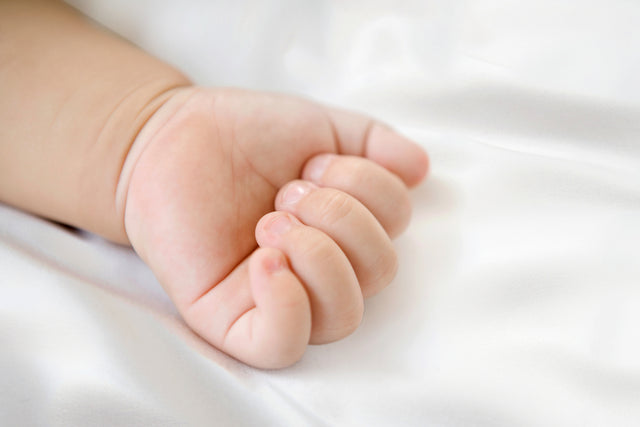Newborn Skincare 101: How to Care for Your Baby’s Delicate Skin

Your newborn’s skin is soft, snuggly…and surprisingly sensitive! In fact, it’s up to 30% thinner than adult skin, making it more prone to dryness, irritation, and even infection. So how do you keep baby’s skin healthy and happy? The good news is: Less is more.
Here’s your go-to guide for caring for your newborn’s skin in those early weeks—and beyond.
Skip the daily baths.
It’s tempting to want to suds your baby up each night, especially since bathtime can be a sweet and soothing bedtime ritual. But daily baths can strip the natural oils that protect your baby’s skin, leaving it dry and irritated. The American Academy of Pediatrics (AAP) recommends bathing newborns just three times a week until they’re crawling around and getting into messes more regularly.
Pro tip: In between baths, gently wipe your baby's neck folds, diaper area, and hands with a soft, damp cloth to keep them clean.
Use gentle cleansers (but sparingly!).
When you do bathe your baby, choose a fragrance-free, hypoallergenic, neutral-PH cleanser formulated for sensitive skin. Harsh soaps can disrupt the skin’s barrier and trigger dryness or eczema. Stick to a pea-sized amount—and skip bubble baths, which can irritate baby’s genitals and lead to rashes or urinary tract infections. And be sure to rinse them well!
Select skin-friendly sheets for sleep.
Babies spend 14 to 18 hours a day sleeping in their earliest months! That means where they sleep really matters. When picking out bassinet and crib sheets, make sure y
Organic cotton is a great choice for being cozy, breathable, and free of irritating chemicals. Another great bet: silk. Happiest Baby’s Silk SNOO Sheet is naturally thermoregulating (so it’s perfectly cozy year-round) and hypoallergenic.
Wrap your baby in organic cotton.
Organic cotton is not only soft and breathable, it’s also less likely to contain potential allergens and formaldehyde resins that can irritate a baby’s delicate skin. That makes it a perfect choice for your baby’s clothes, bedding, and more. (Our SNOO Sacks, Sleepeas, swaddle blankets, and original fitted sheets are all made with 100% organic cotton!)
Don’t pick at peeling skin.
Newborn skin often peels in the first few weeks. It’s completely normal and doesn’t need to be treated or picked at. Moisturizer won’t stop the peeling, but it can ease dryness and protect skin as it sloughs off naturally.
Pick fragrance-free creams or ointments over lotions (which are thinner and more likely to contain alcohol). The AAP suggests applying a gentle moisturizer immediately after bathtime while your baby’s skin is still slightly damp to help lock in moisture.
Use fragrance-free detergent.
Wash clothing, bedding, and swaddles (anything that touches your sweet babe’s skin) in non-irritating, fragrance-free soap. (Read up on contact dermatitis in babies.)
Let the umbilical cord fall off naturally.
It may look a little odd, but don’t worry—your baby’s umbilical stump is doing its job and will fall off on its own in about 1 to 3 weeks. Until then, keep the area clean and dry. The AAP and CDC recommend sponge baths until the stump drops off. Avoid covering the stump with the diaper; instead, fold the diaper below it to let air circulate and promote healing. (Learn more about caring for your baby’s umbilical cord stump!)
Watch for rashes.
Newborn rashes are common and usually harmless. Some of the most frequent include:
- Diaper rash: Change diapers frequently and use a zinc oxide barrier cream as needed.
- Erythema toxicum: This newborn rash looks alarming (it usually appears as a bunch of red, fluid-filled bumps) but is totally normal and fades on its own.
- Milia: Tiny white bumps on the face are also harmless and disappear in time.
If a rash seems painful, spreads quickly, or is accompanied by fever or other symptoms, reach out to your pediatrician to rule out an infection or allergy.
Change diapers often.
To keep diaper rash at bay, make sure you’re putting on a new diaper every 2 to 3 hours and right after your baby poops. (Related: How many diapers does a newborn use?)
Dress your baby for the weather.
Overheating can irritate baby skin, so keep things cool and breathable. A good rule of thumb: Dress your baby in one more layer than you’re wearing. In the winter, avoid wool or scratchy fabrics and layer soft cotton onesies and footed pajamas. In warm weather, keep your baby shaded and cool, and avoid sunscreen until baby is at least 6 months old. Instead, cover up with a hat, long sleeves, and seek shade. (More tips on how to dress a newborn!)
More on Baby Care:
- Baby Acne: What to Do About Infant Pimples
- How to Trim Your Baby’s Nails
- Do Babies Need Lotion?
- Your Diaper Blowout Survival Guide
***
REFERENCES
- American Academy of Dermatology: How to Bathe a Newborn
- American Academy of Family Physicians: Bathing Your Newborn, American Family Physician, January 2008
- American Academy of Pediatrics: Bathing Your Newborn
- Cleveland Clinic: Milia
- Mayo Clinic: Newborn Care Basics—What You Need to Know
- National Center for Biotechnology Information: Bathing and Beyond—Current and Emerging Evidence on Skin Care of the Neonate
View more posts tagged, baby care
Have questions about a Happiest Baby product? Our consultants would be happy to help! Submit your questions here.